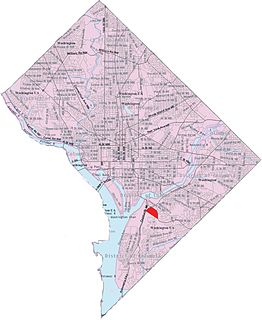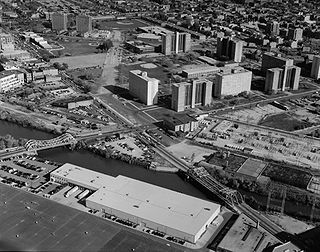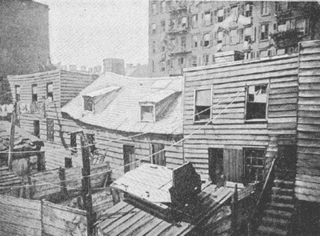Related Research Articles

Urban renewal is a program of land redevelopment often used to address urban decay in cities. Urban renewal involves the clearing out of blighted areas in inner cities to clear out slums and create opportunities for higher class housing, businesses, and other developments.

Sursum Corda is a small neighborhood located in Washington, D.C., bounded by North Capitol Street on the east, K Street NW to the south, New Jersey Avenue NW to the west, and New York Avenue NW to the north.

Yesler Terrace, a 22-acre (8.9 ha) public housing development in Seattle, Washington was, at the time of its completion in 1941, Washington state's first public housing development and the first racially integrated public housing development in the United States. It occupies much of the area formerly known as Yesler Hill, Yesler's Hill, or Profanity Hill. The development is administered by the Seattle Housing Authority, who have been redeveloping the neighborhood into a mixed-income area with multi-story buildings and community amenities since 2013.
Berman v. Parker, 348 U.S. 26 (1954), is a landmark decision of the United States Supreme Court that interpreted the Takings Clause of the Fifth Amendment to the United States Constitution. The Court voted 8–0 to hold that private property could be taken for a public purpose with just compensation. The case laid the foundation for the Court's later important public use cases, Hawaii Housing Authority v. Midkiff, 467 U.S. 229 (1984) and Kelo v. City of New London, 545 U.S. 469 (2005).
HOPE VI is a program of the United States Department of Housing and Urban Development. It is intended to revitalize the worst public housing projects in the United States into mixed-income developments. Its philosophy is largely based on New Urbanism and the concept of defensible space.

Barry Farm is a neighborhood in Southeast Washington, D.C., located east of the Anacostia River and bounded by the Southeast Freeway to the northwest, Suitland Parkway to the northeast and east, and St. Elizabeths Hospital to the south. The neighborhood was renowned as a significant post-Civil-War settlement of free Blacks and freed slaves established by the Freedmen's Bureau. The streets were named to commemorate the Union generals, Radical Republicans, and Freedmen's Bureau officials who advanced the rights of Black Americans during the Civil War and Reconstruction: Howard Road SE for General Oliver O. Howard; Sumner Road SE for Massachusetts Senator Charles Sumner; Wade Road SE for Ohio Senator Benjamin Wade; Pomeroy Road SE for Kansas Senator Samuel C. Pomeroy; Stevens Road SE for Pennsylvania Congressman Thaddeus Stevens, and Nichols Road for Danforth P Nichols. The neighborhood name is not a reference to the late former mayor of Washington, D.C., Marion Barry, but coincidentally has the same spelling.

The Southwest Waterfront is a mostly residential neighborhood in Southwest Washington, D.C. The Southwest quadrant is the smallest of Washington's four quadrants, and the Southwest Waterfront is one of only two residential neighborhoods in the quadrant; the other is Bellevue, which, being east of the Anacostia River, is frequently, if mistakenly, regarded as being in Southeast. For that reason, many residents of Southwest Waterfront will refer to themselves as living in "Southwest."

Capitol View is a neighborhood located in southeast Washington, D.C., in the United States. It is bounded by East Capitol Street to the north, Central Avenue SE to the southwest and south, and Southern Avenue SE to the southeast. Still overwhelmingly African-American, it is a thriving middle class neighborhood. Parts of the neighborhood became one of the city's most violent and drug-ridden areas in the 1980s and 1990s. The Capitol View neighborhood saw several large, poorly maintained public housing projects demolished in the 2010s. The government of the District of Columbia partnered with private real estate developers to construct the Capitol Gateway mixed-use development between 2000 and 2010.

Washington Highlands is a residential neighborhood in Southeast Washington, D.C., in the United States. It lies within Ward 8.

Marshall Heights is a residential neighborhood in Southeast Washington, D.C. It is bounded by East Capitol Street, Central Avenue SE, Southern Avenue, Fitch Street SE, and Benning Road SE. It was an undeveloped rural area occupied by extensive African American shanty towns, but the neighborhood received nationwide attention after a visit by First Lady Eleanor Roosevelt in 1934, which led to extensive infrastructure improvements and development for the first time. In the 1950s, Marshall Heights residents defeated national legislation designed to raze and redevelop the neighborhood. Queen Elizabeth II of the United Kingdom visited the area in 1991, at a time when Marshall Heights was in the throes of a violent crack cocaine epidemic. Limited redevelopment has occurred in the neighborhood, which was the site of two notorious child murders in 1973.

The American Housing Act of 1949 was a landmark, sweeping expansion of the federal role in mortgage insurance and issuance and the construction of public housing. It was part of President Harry Truman's program of domestic legislation, the Fair Deal.

The Housing Act of 1937, formally the "United States Housing Act of 1937" and sometimes called the Wagner–Steagall Act, provided for subsidies to be paid from the U.S. government to local public housing agencies (LHAs) to improve living conditions for low-income families.
Michael P. Kelly is an architect and urban planner who has led the public housing authorities of several large U.S. cities, and is a leading advocate for public policy that promotes affordable housing in the country.
Ernest J. Bohn was an American politician. He was a leading figure in public housing from the 1930s until his death. He spent the majority of his life promoting the creation of public housing in Ohio, particularly in Cleveland, and his work created standards copied across the nation. Thanks to his efforts, Cleveland became a leader in public housing, creating the first public housing authority, Cleveland Metropolitan Housing Authority, and creating some of the largest public housing developments in the nation.

Snow's Court is an alley of historic dwellings located in the Foggy Bottom neighborhood in Washington D.C.
The Alley Dwelling Authority was a government funded program that sought to help with the development of alley dwellings in Washington, D.C. Alleys in Washington suffered from a variety of problems, most prominently overpopulation and poverty that increased rapidly over the 1800s, particularly in Foggy Bottom. In 1822, the neighborhood had an estimated forty households with a majority of skilled workers; however, by 1860 there were around 175 households. This drastic change yielded the percentage of skilled workers and unskilled workers to fluctuate. This suggests that there was a boom in the economy and a drastic change in the need for factory hands. This change was beneficial because it created greater numbers to flock into these new areas of Foggy Bottom, then forcing groups like the Alley Dwelling Authorities to step in and reconstruct old dilapidated homes.

The District of Columbia Housing Authority is an independent government agency whose mission is to provide affordable housing to extremely low- through moderate-income households, foster sustainable communities, and cultivate opportunities for residents to improve their lives throughout the eight wards of Washington, D.C.

Slum clearance in the United Kingdom has been used as an urban renewal strategy to transform low income settlements with poor reputation into another type of development or housing. Early mass clearances took place in the country's northern cities. Starting from 1930, councils were expected to prepare plans to clear slum dwellings, although progress stalled upon the onset of World War II.

Slum clearance in the United States has been used as an urban renewal strategy to regenerate derelict or run-down districts, often to be replaced with alternative developments or new housing. Early calls were made during the 19th century, although mass clearance did not occur until after World War II with the introduction of the Housing Act of 1949 which offered federal subsidies towards redevelopments. The scheme ended in 1974 having driven over 2000 projects with costs in excess of $50 billion.
Edith Elmer Wood was an American advocate for public health and housing reform. Wood was a proponent of the construction of public housing, arguing that overcrowded slums and their associated communicable diseases were not the fault of immoral tenants or landlords, but a systemic economic problem needing solutions at the governmental level. She served in leadership roles for several housing organizations and was an advisor to the United States Housing Authority; her advocacy had significant impacts on the housing reforms implemented in the 1930s and 1940s through the New Deal and the Fair Deal.
References
- ↑ Gillette, Howard (1995). Between Justice and Beauty. Baltimore: Johns Hopkins University Press. pp. 136–148. ISBN 0-8018-5069-X.
- ↑ Southwest Housing, the Washington Post, Dec. 7, 1952.
- ↑ John Ihlder Manuscript Collection [ permanent dead link ]